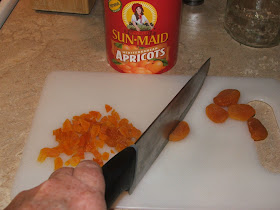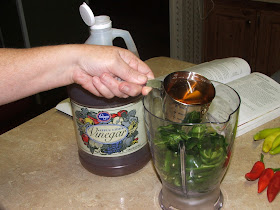When I was a little girl, my Granny Smith always had a row of crocks in her cellar filled with pickles, pickled beans, pickled corn, and sauerkraut. These brine and vegetable filled vessels intrigued and fascinated me... in went a little salt, some clear, clean water, and the vegetable of choice... and out came a tasty treat! Granny always broke her corn cobs into 2-3 inch pieces for pickling... just the perfect size for tiny hands to enjoy.
Granny pickled because it was a great way preserve the crops of cabbage, corn, beans, cucumbers. Fermenting foods (that's what pickling in brine is!) was a way of life... and we've removed ourselves from it very much in this modern day of preservatives and over-processing, much to the detriment of our digestive systems... Fermented food:
1.
Improves digestion... Fermenting our foods before we eat them is like partially digesting them before we consume them. According to Joanne Slavin, a professor in the Department of Food Science at the University of Minnesota, "... sometimes people who cannot tolerate milk can eat yogurt. That's because the lactose (which is usually the part people can't tolerate) in milk is broken down as the milk is fermented and turns into yogurt."
2.
Restore the proper balance of bacteria in the gut... Do you suffer from lactose intolerance? Gluten intolerance? Constipation? Yeast infections? Allergies? Asthma? All these conditions have been linked to a lack of good bacteria in the gut.
3.
Raw, fermented foods are rich in enzymes... According to the Food Renegade blog, "Your body needs enzymes to properly digest, absorb, and make full use of your food. As you age, your body's supply of enzymes decreases. This has caused many scientists to hypothesize that if you could guard against enzyme depletion, you could live a longer, healthier life."
4.
Fermenting food actually increases the vitamin content.
5.
Eating fermented food helps us to absorb the nutrients we're consuming.
6.
Fermenting food helps to preserve it for longer periods of time... milk goes bad quicker than yogurt, sauerkraut, pickles and salsa will keep for months.
7.
Fermenting food is inexpensive.
8.
Fermenting food increases the flavor... There's a reason humans enjoy drinking wine and eating stinky cheese. There's a reason we like sauerkraut on our hot dogs and salsa on our tortilla chips. It tastes good!
OK... science lesson over...
I made sauerkraut and here's what I did...
The recipe I have called for 25 pounds of cabbage... I only had 8 pounds...
And it called for 1 cup of canning and pickling salt... I used 1/4 cup...
After peeling the outer leaves from my cabbage, removing the stem end, and weighing it, I used the slicer attachment on my KitchenAid to shred the cabbage (a food processor with slicing attachment can be used, you can use a mandoline, or you CAN use the old fashioned method of knife and cutting board, slicing thinly... you want your cabbage about 1/16 inch thick)...
Once I had chopped all my cabbage...
I put it all in a food grade plastic bucket (I used a 5 gallon bucket even though I only had about a gallon of cabbage)... a stone crock would have been nice, but I don't own one... it's on my list!
I mixed the 1/4 cup of canning and pickling salt thoroughly into the shredded cabbage. If I had followed the full 25 pounds of cabbage recipe, I would have worked in 5 pound batches at a time, layering cabbage, then salt and working it in as I went along, waiting about 15 minutes between layers.
After I had mixed the salt into the cabbage well, I let it sit for about 15 minutes and checked to make sure there was enough juice flowing to cover the cabbage. If the water was enough to cover the cabbage I would have moved on to the next step, however, my cabbage wasn't producing enough of its own juices so I mixed up a batch of brine using 4-1/2 teaspoons of pickling salt to 4 cups of water, heating it on medium high to allow the salt to dissolve, then letting it cool to room temperature. I added the brine to the cabbage in the bucket.
The cabbage needs to remain submerged under an inch or two of water, so I placed a glass pie plate on top of the mixture and weighted it down with two quart jars filled with water.
I covered the bucket loosely with a dish towel and put the bucket lid over top, loosely. I placed the bucket of sauerkraut in a consistently cool place...
And then you wait...
... and let it ferment...
Fermentation takes place best at a cool temperature between 70 and 75 degrees F. At this temperature fermentation should take about 3 weeks. At a slightly lower temperature, between 60 and 65 degrees, fermentation may take 5 or 6 weeks to complete. If the storage is below 60 degrees fermentation may not take place. At temperatures higher than 75 degrees pickles may become soft (not sure what happens to cabbage, but didn't want to take any chances, so I kept my mixture in an area that stays between 70 and 75 degrees)
I checked the mixture every day and removed any scum that had formed. During fermentation, gas bubbles will form. When the bubbling ceases, fermentation is complete.
 |
I didn't have a lot of scum to remove, thankfully,
but one time there was a big ol' glob, easily skimmed off
(I know, EWWWW, but it's a fact of life in fermenting that
we must face *grin* |
Once fermentation is complete (took my sauerkraut about three weeks), and scum is removed, it's time to can it up (if you don't have a fabulous root cellar or stone crocks to store it in, that is... I must can mine!)
I decided to hot pack my sauerkraut, so I poured it from the bucket into a large stockpot to heat it up, bringing it to a simmer over medium-high heat, but not to a boil.
I prepared my pint canning jars by placing them in a flat pan of boiling water set over two stove eyes. I prepared my lids by simmering them in hot water until I was ready for them. Once my sauerkraut was heated through and my jars and lids were hot, I packed the hot sauerkraut and brine into the hot jars, leaving a half inch of headspace.
I removed any air bubbles and adjusted headspace, if necessary by adding more brine. I wiped the jar rims...
...and tightened the lids and rings on to fingertip tightness...
I placed the jars into my canner, ensuring they were completely covered with water. I brought the water to a boil and processed the pint jars in the boiling water bath for 10 minutes (quarts would be processed for 15 minutes) I removed the canner lid after processing and removed the jars using my jar lifter...
... then set my jars on a folded dish towel on the counter to cool and to listen for the PING of each successfully sealed jar.
Now for a hot dog with sauerkraut and spicy mustard!
































































